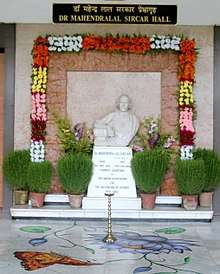Mahendralal Sarkar
Mahendralal Sarkar CIE (other spellings: মহেন্দ্রলাল সরকার, Mahendra Lal Sarkar, Mahendralal Sircar, Mahendralal Sircir; 2 November 1833 – 23 February 1904) was a Bengali medical doctor (MD), the second MD graduated from the Calcutta Medical College, social reformer, and propagator of scientific studies in nineteenth-century India. He was the founder of the Indian Association for the Cultivation of Science.[1][2]
Mahendralal Sarkar | |
|---|---|
 | |
| Born | 2 November 1833 Paikpara village, Howrah district, India |
| Died | 23 February 1904 (aged 70) Calcutta, India |
| Occupation | Physician, academic |
| Spouse(s) | Rajkumari |
Early life and education
Mahendralal Sarkar was born at Paikpara village in Howrah district, near Calcutta (now known as Kolkata) in the Bengal Province of British India. He lost both his parents early in life, his father when he was five years old and his mother when he was nine years old. His mother had shifted to his maternal uncles' house earlier, and subsequently he was brought up by his maternal uncles, Iswar Chandra Ghosh and Mahesh Chandra Ghosh in their house at Nebutala in Calcutta. First he was sent to a "gurumasai" or tutor to learn Bengali, and subsequently to another tutor named Thakurdas Dey, to learn English. On learning some English he secured admission in Hare School as a free student in 1840. In 1849, he passed the junior scholarship examination and joined Hindu College, where he studied up to 1854. At that time, Hindu College did not have facilities for teaching science and as he was bent upon studying medicine, he transferred to Calcutta Medical College.
At Calcutta Medical College he was so esteemed by his professors that in the second year of his course he was invited by them to deliver a series of lectures on optics to his fellow students, a task he performed honourably. He had a brilliant career at that college, where, besides winning several scholarships, he passed the final examination in 1860 with the highest honours in medicine, surgery and midwifery. In 1863, he took the degree of M.D. with special success.[3] He and Jagabandhu Bose were the second MDs of the Calcutta University after Chandrakumar De (1862).[1][4][5]
Career
Although educated in the traditional European system of medicine, Mahendralal Sarkar turned to homoeopathy. He was influenced by reading William Morgan's The Philosophy of Homeopathy, and by interaction with Rajendralal Dutt, a leading homoeopathic practitioner of Calcutta. In a meeting of the Bengal branch of the British Medical Association, he proclaimed homoeopathy to be superior to the "Western medicine" of the time. Consequently, he was ostracised by the British doctors, and had to undergo loss in practice for some time.[6] However, soon he regained his practice and went on to become a leading homoeopathic practitioner in Calcutta, as well as India.[1]
In the course of his career, he treated several notable persons of those days, including the author Bankimchandra Chattopadhyay, the ascetic Ramakrishna, the Maharaja of Tripura and others.
Campaigning scientific knowledge and higher education

Mahendralal Sarkar started a campaign in 1867 for a national science association. He planned for an association that would be funded, run, and managed by native Indians, with the aim of turning out a pool of scientists for national reconstruction.[1] The Indian Association for the Cultivation of Science (IACS) was established in 1876, and Sarkar was its first secretary.[7] IACS was the first national science association of India.[8] Basic science departments such as Physics, Chemistry, Mathematics, Physiology, Geology, Botany, etc. were established, and notable Indian scientists participated in the association. Regular lectures and demonstrations were arranged for the public to popularise science.[8]
Sarkar supported women's education in nineteenth-century India, when higher education among women was rare. For example, he was a supporter of Abala Bose's decision to pursue the study of medicine at Madras Medical College instead of Calcutta Medical College, where admission of females was not permitted. He also arranged for Sarala Devi Chaudhurani's attendance in the evening lectures at IACS, so that she could pursue higher studies in physics.[9]
Awards and honours
He was a fellow of Calcutta University and an honorary magistrate and Sheriff of Calcutta (1887). He was made a CIE in 1883 and honoured with an honorary doctorate degree by University of Calcutta in 1898.[5]
References
| Wikimedia Commons has media related to Mahendralal Sarkar. |
- Palit, Chittabrata (2012). "Sircir, Mahendralal". In Islam, Sirajul; Jamal, Ahmed A. (eds.). Banglapedia: National Encyclopedia of Bangladesh (Second ed.). Asiatic Society of Bangladesh.
- Arun Kumar Biswas. Gleanings of the past and the science movement : in the diaries of Drs. Mahendralal and Amritalal Sircar, Calcutta : The Asiatic Society, 2000; see also Collected works of Mahendralal Sircar, Eugene Lafont, and science movement, 1860–1910, Kolkata : Asiatic Society, 2003
- Dr. Mahendralal Sircar – Frank Parlato Jr. Vivekananda.net. Retrieved on 12 November 2018.
- Sastri, Sivanath, Ramtanu Lahiri O Tatkalin Banga Samaj, 1903/2001, (in Bengali), pp. 170–176, New Age Publishers Pvt. Ltd.
- Sengupta, Subodh Chandra and Bose, Anjali (editors), 1998 edition, Sansad Bangali Charitabhidhan (Biographical dictionary) Vol I, (in Bengali), p. 408, ISBN 81-85626-65-0
- Das, Eswara (2005). "India". History & Status of Homoeopathy Around the World. B. Jain Publishers. pp. 103–107. ISBN 81-8056-573-4.
- IACSCC. "Introduction(About) of IACS". www.iacs.res.in. Retrieved 18 September 2016.
- Palit, Chittabrata (2012). "Indian Association for the Cultivation of Science". In Islam, Sirajul; Jamal, Ahmed A. (eds.). Banglapedia: National Encyclopedia of Bangladesh (Second ed.). Asiatic Society of Bangladesh.
- Thorner, Alice; Raj, Maithreyi Krishna (2000). Ideals, Images, and Real Lives: Women in Literature and History. Sameeksha Trust. Orient Longman. pp. 51–52. ISBN 81-250-0843-8.